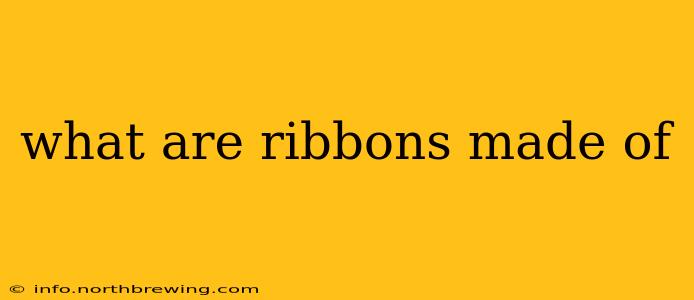Ribbons, those seemingly simple strips of fabric, hold a surprising amount of history and complexity in their creation. From elegant gift wrapping to prestigious medals, the material composition of a ribbon significantly impacts its appearance, durability, and application. Understanding what ribbons are made of unlocks a world of detail and appreciation for this versatile material.
What are the most common materials used to make ribbons?
The most common materials used for ribbon manufacturing are synthetic fibers and natural fibers. Let's explore each category:
Synthetic Fibers: These dominate the ribbon market due to their affordability, versatility, and durability. The most prevalent synthetic fibers include:
- Polyester: Known for its strength, sheen, and resistance to fading and shrinking, polyester is a popular choice for many ribbon types, especially those used for printing or requiring vibrant colors. Its wrinkle-resistant properties also make it ideal for various applications.
- Nylon: Offering exceptional strength and elasticity, nylon ribbons are often used where durability is paramount. They can withstand significant stress without tearing or fraying, making them suitable for industrial applications or high-stress situations.
- Satin: While often associated with a specific fabric, satin is actually a weave, often made from synthetic fibers like polyester or nylon. The smooth, lustrous finish makes satin ribbons popular for decorative purposes, especially in crafting and gift-wrapping.
- Polypropylene: A less expensive option, polypropylene ribbons are lightweight and water-resistant, frequently used for packaging, crafts, and situations where cost-effectiveness is prioritized.
Natural Fibers: While less common than synthetics due to higher costs and potential for degradation, natural fibers still hold a place in ribbon manufacturing. These include:
- Silk: Renowned for its luxurious feel, drape, and sheen, silk ribbons are prized for their elegance and are typically used in high-end applications, such as haute couture or heirloom crafts.
- Cotton: A softer, more absorbent option, cotton ribbons are often used in crafting and potentially in applications requiring a more natural or eco-friendly material.
- Linen: Similar to cotton, linen offers a slightly more textured and durable feel. Linen ribbons are often favored for their unique aesthetic.
What different types of ribbon finishes are there?
The finish of a ribbon significantly influences its appearance and texture. Several types exist:
- Satin: As mentioned earlier, the smooth, lustrous finish is highly sought after for its elegance.
- Grosgrain: This ribbon features a ribbed texture, providing a more substantial and less slippery feel than satin. It's popular for bows and accents.
- Organza: A sheer, lightweight ribbon with a slightly crisp texture, organza is ideal for delicate applications and adds a touch of transparency.
- Velvet: Luxurious and plush, velvet ribbons add a tactile and visually rich element to projects.
How are ribbons made?
Ribbon manufacturing is a complex process that involves several steps, generally including:
- Fiber production: The chosen fiber is either spun or produced synthetically.
- Warping: The fibers are then carefully arranged onto a warp beam.
- Weaving or knitting: The fibers are woven or knitted into the desired ribbon structure.
- Finishing: Processes such as dyeing, printing, and cutting finalize the ribbon to the desired specifications.
Are there eco-friendly ribbon options?
Yes, increasingly, manufacturers offer eco-friendly alternatives. These often utilize recycled materials or plant-based fibers, reducing the environmental impact of ribbon production. Look for ribbons labeled as organic cotton, recycled polyester, or other sustainable materials.
What is the difference between ribbon and tape?
While both are narrow strips, ribbons are typically made of woven or knitted fabrics (as detailed above), while tape is generally made of a continuous material such as plastic, paper, or adhesive-coated fabric. Ribbons often have a more decorative purpose, whereas tape is frequently used for binding, sealing, or labeling.
This comprehensive overview should provide a thorough understanding of what ribbons are made of, their diverse applications, and the manufacturing process behind them. Remember to consider the material composition and finish when selecting ribbons for your specific project to achieve the desired aesthetic and functionality.
